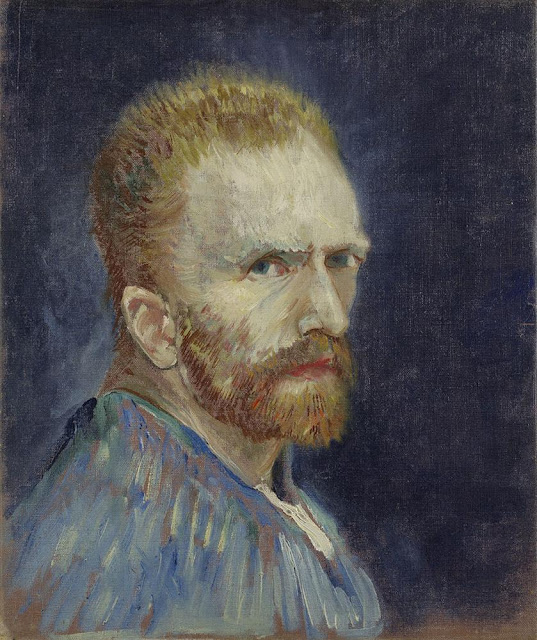 |
| Vincent van Gogh Self-portrait ca. 1887 oil on canvas Wadsworth Atheneum, Hartford, Connecticut |
Mr. Knott ate this dish with a little plated trowel, such as confectioners and grocers use, and tea-merchants.
This arrangement represented a great saving of labour. Coal also was economized.
To whom, Watt wondered, was this arrangement due? To Mr. Knott himself? Or to some other person, to a past domestic of genius for example, or a professional dietician? And if not to Mr. Knott himself, but to some other person (or of course persons), did Mr. Knott know that such an arrangement existed, or did he not?
Mr. Knott was never heard to complain of his food, though he did not always eat it. Sometimes he emptied the bowl, scraping its sides, and bottom, with the trowel, until they shone, and sometimes he left the half of it, or some other fraction, and sometimes he left the whole of it.
Twelve possibilities occurred to Watt, in this connexion:
 |
| Jacques Antoine Vallin Portrait of a Young Lady in Classical Dress early 19th century oil on canvas private collection |
1. Mr. Knott was responsible for the arrangement, and he knew that he was responsible for the arrangement, and knew that such an arrangement existed, and was content.
 |
| Eugène Vidal Girl resting on her arms 19th century oil on canvas private collection |
2. Mr. Knott was not responsible for the arrangement, but knew who was responsible for the arrangement, and knew that such an arrangement existed, and was content.
 |
| Louis Léopold Boilly Gabrielle Arnault as a child ca. 1815 oil on canvas Louvre |
3. Mr. Knott was responsible for the arrangement, and knew that he was responsible for the arrangement, but did not know that any such arrangement existed, and was content.
 |
| François Xavier Fabre Portrait of a man 1809 oil on canvas National Gallery of Scotland |
4. Mr. Knott was not responsible for the arrangement, but knew who was responsible for the arrangement, but did not know that any such arrangement existed, and was content.
 |
| Jean Auguste Dominique Ingres Ferdinand Philippe, duc d'Orléans 1844 oil on canvas Wadworth Atheneum, Hartford, Connecticut |
5. Mr. Knott was responsible for the arrangement, but did not know who was responsible for the arrangement, nor that any such arrangement existed, and was content.
 |
| Jacques Henner Woman with Red Hair ca. 1880 oil on panel Wadsworth Atheneum, Hartford, Connecticut |
6. Mr. Knott was not responsible for the arrangement, nor knew who was responsible for the arrangement, nor that any such arrangement existed, and was content.
 |
| Anne Louis Girodet Portrait of Queen Hortense 1808 oil on canvas Rijksmuseum |
7. Mr. Knott was responsible for the arrangement, but did not know who was responsible for the arrangement, and knew that such an arrangement existed, and was content.
 |
| Théodore Géricault Portrait of a Kleptomaniac ca. 1820 oil on canvas Museum voor Schone Kunsten, Ghent |
8. Mr. Knott was not responsible for the arrangement, nor knew who was responsible for the arrangement, and knew that such an arrangement existed, and was content.
 |
| Carolus Duran Portrait of Hector Hanoteau 1870 oil on canvas private collection |
9. Mr. Knott was responsible for the arrangement, but knew who was responsible for the arrangement, and knew that such an arrangement existed, and was content.
 |
| Thomas Couture Head of a woman ca. 1855 oil on canvas Wadswoth Atheneum, Hartford, Connecticut |
10. Mr. Knott was not responsible for the arrangement, but knew that he was responsible for the arrangement, and knew that such an arrangement existed, and was content.
 |
| Claude Marie Dubufe The Dubufe family 1820 oil on canvas Louvre |
11. Mr. Knott was responsible for the arrangement, but knew who was responsible for the arrangement, but did not know that any such arrangement existed, and was content.
 |
| Pierre Paul Prud'hon Princess Talleyrand 1807-08 pastel Hermitage |
12. Mr. Knott was not responsible for the arrangement, but knew that he was responsible for the arrangement, but did not know that any such arrangement existed, and was content.
 |
| Odilon Redon Closed Eyes 1890 oil on canvas Musée d'Orsay, Paris |
Other possibilities occurred to Watt, in this connexion, but he put them aside, and quite out of his mind, as unworthy of serious consideration, for the time being.
– text by Samuel Beckett, from his second novel, Watt (written between 1941 and 1945, first published in 1953)